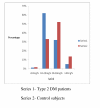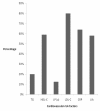Lipoprotein (a), C-reactive protein and some metabolic cardiovascular risk factors in type 2 DM
- PMID: 20663222
- PMCID: PMC2919447
- DOI: 10.1186/1758-5996-2-51
Lipoprotein (a), C-reactive protein and some metabolic cardiovascular risk factors in type 2 DM
Abstract
Background: Lipoprotein (a) (LP (a) is an independent cardiovascular risk factor that is not widely studied in people of sub-Saharan African origin. The aim of this report is to determine the frequency of occurrence of elevated Lp (a) and possible relationship with total cholesterol (TCHOL), high density lipoprotein cholesterol (HDL-C), low density lipoprotein cholesterol (LDL-C), triglycerides (TG), C reactive protein (CRP) and serum uric acid (SUA).
Methods: This is a cross sectional study carried out in 200 Nigerian patients with type 2 DM and 100 sex and age matched healthy Controls aged between 32-86 years. We determined the frequency of occurrence of elevated Lp (a) levels in the study subjects and compared clinical and biochemical variables between type 2 diabetic patients and non-diabetic patients. Clinical and biochemical parameters were also compared between subjects with type 2 DM who had elevated LP (a) and normal LP (a) levels. Long term glycaemic control using glycosylated haemoglobin was determined and compared in the study subjects. Test statistics used include chi square, correlation coefficient analysis and Student's t test.
Results: The mean Lp(a) concentration differed significantly between type 2 diabetic patients and the Control subjects (18.7 (5.8) mg/dl vs 23 (6.8) mg/dl, 0.00001). Similarly, the prevalence of high LP (a) levels in type 2 DM patients was significantly higher than that of the Control subjects (12.5% vs 4%, p-0.019). The mean levels of the lipid profile parameters (TCHOL, LDL-C, TG, LDL/HDL) and CRP were significantly higher in DM patients than in the Control subjects. The mean LP (a) levels were comparable in both sexes and in DM subjects with and without hypertension. TG was the only parameter that differed significantly between subjects with elevated Lp (a) levels and those with normal Lp (a) levels. There was a significant positive correlation (r) between Lp(a) levels and TG, LDL-C. TCHOL, LDL/HDL and uric acid. No association was found between Lp(a) and clinical parameters such as age and anthropometric indices.
Conclusion: We have showed that Lp (a), CRP and other CVS risk factors cluster more in patients with DM than non DM patients. Serum Lp (a) levels are not associated with anthropometric and glycaemic indices.
Figures
Similar articles
-
Lipoprotein (a) and other risk factors in children with insulin-dependent diabetes mellitus and children without diabetes.Diabete Metab. 1994 Nov-Dec;20(6):522-5. Diabete Metab. 1994. PMID: 7713274 Clinical Trial.
-
Glycaemic indices and non-traditional biochemical cardiovascular disease markers in a diabetic population in Nigeria.J Coll Physicians Surg Pak. 2011 Aug;21(8):455-9. J Coll Physicians Surg Pak. 2011. PMID: 21798129
-
Clinical investigation of lipoprotein (a) levels in type 2 diabetics for cardiovascular diseases prediction and prognosis.Horm Mol Biol Clin Investig. 2022 Apr 15;43(3):263-271. doi: 10.1515/hmbci-2021-0090. eCollection 2022 Sep 1. Horm Mol Biol Clin Investig. 2022. PMID: 35427448
-
Characterization of lipid parameters in diabetes mellitus--a Nigerian report.Int Arch Med. 2009 Jul 20;2(1):19. doi: 10.1186/1755-7682-2-19. Int Arch Med. 2009. PMID: 19619328 Free PMC article.
-
Lipoprotein(a), cardiovascular disease, and contemporary management.Mayo Clin Proc. 2013 Nov;88(11):1294-311. doi: 10.1016/j.mayocp.2013.09.003. Mayo Clin Proc. 2013. PMID: 24182706 Review.
Cited by
-
Does atorvastatin work more effectively than biguanides in reducing cardiovascular risk factors?J Pharm Bioallied Sci. 2011 Apr;3(2):306-9. doi: 10.4103/0975-7406.80767. J Pharm Bioallied Sci. 2011. PMID: 21687364 Free PMC article.
-
Serum Lipoprotein (a) Levels in Black South African Type 2 Diabetes Mellitus Patients.Oxid Med Cell Longev. 2016;2016:5743838. doi: 10.1155/2016/5743838. Epub 2016 Oct 19. Oxid Med Cell Longev. 2016. PMID: 27833702 Free PMC article.
-
Lipoprotein (a) and atherogenic indices in Sudanese patients with type 2 diabetes.Int J Health Sci (Qassim). 2014 Jul;8(3):237-46. doi: 10.12816/0023976. Int J Health Sci (Qassim). 2014. PMID: 25505859 Free PMC article.
-
Investigating the Atherogenic Risk of Lipoprotein(a) in Type 2 Diabetic Patients.Cureus. 2018 Jul 23;10(7):e3030. doi: 10.7759/cureus.3030. Cureus. 2018. PMID: 30254819 Free PMC article.
-
Variations of lipoprotein(a) levels in the metabolic syndrome: a report from the Maracaibo City Metabolic Syndrome Prevalence Study.J Diabetes Res. 2013;2013:416451. doi: 10.1155/2013/416451. Epub 2013 Apr 22. J Diabetes Res. 2013. PMID: 23710466 Free PMC article.
References
-
- Alberti KG, Eckel RH, Grundy SM, Zimmet, Paul Z, Cleeman, James I. Donato Karen Harmonizing the metabolic syndrome. A joint interim statement of the International Diabetes Federation Task Force on Epidemiology and Prevention; National Heart, Lung, and Blood Institute; American Heart Association; World Heart Federation; International Atherosclerosis Society; and International Association for the Study of Obesity. Circulation. 2009;120:1640–1645. doi: 10.1161/CIRCULATIONAHA.109.192644. - DOI - PubMed
-
- Romics L, Karadi I, Csaszar A, Kostner G. Physiological and Clinical Importance of Lipoprotein(a) J Exp Clin Med. 1990;15:149–1541. - PubMed
LinkOut - more resources
Full Text Sources
Research Materials
Miscellaneous




